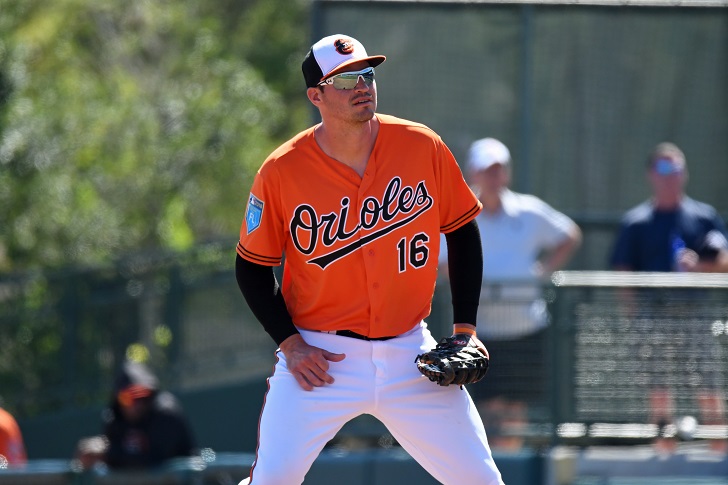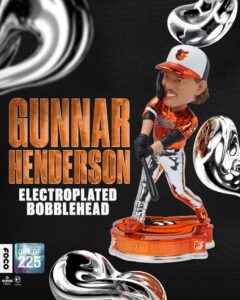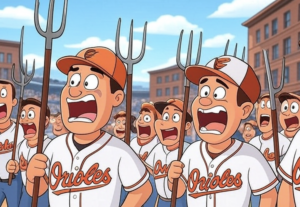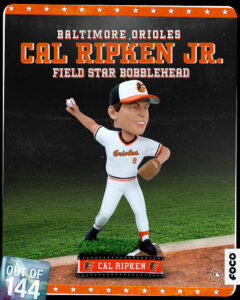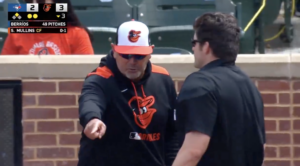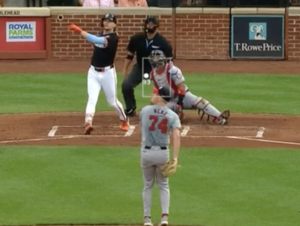Another year of Baltimore Orioles baseball is in the books. The Birds finished the 2021 season with a 52-110 record, tied with the Arizona Diamondbacks for worst in Major League Baseball.
However, following the conclusion of the Orioles’ season this past weekend, it’s important to realize some of the positive takeaways:
* Cedric Mullins put together the first 30-30 season in Orioles history and was one of the best outfielders in MLB in 2021
* John Means threw a no-hitter in Seattle
* Ryan Mountcastle broke the record for home runs by an Orioles’ rookie
* Tyler Wells showed promise in relief as a potential successful Rule 5 Draft pick by the Orioles
* The farm system continues to grow and give hope that better years are ahead
All these were fun to witness and experience through the dreadful Orioles’ season, but none of them pulled on the heartstrings quite as much as Trey Mancini when he took the field on opening day. Mancini missed the 2020 season after being diagnosed with stage 3 colon cancer. He completed chemotherapy in September 2020 and revealed to reporters the following November that he was cancer-free and ready for the 2021 season.
Mancini sure was ready.
Not only did the 29-year old come back to baseball, but he played in 147 games, slashing .255/.326/.432 with 21 home runs. If he isn’t American League Comeback Player of the Year, something has gone terribly wrong.
Following his triumphant return to baseball and completing his first full season since beating cancer, the only unknown is what his future holds with the Orioles.
Next year will be Mancini’s final season under club control before reaching free agency. Will the Orioles start engaging in contract extension conversations with Mancini this offseason? Will the team explore the possibility of trading him to further stock up the farm in a rebuild? Or will they ride out his final arbitration year and decide to cross this path at a later date?
Give me your patience, as this may take a while. After all, there isn’t a simple answer as “yes” or “no” to question No. 1.
Personally, I would love to have Mancini stick around in Birdland both during and beyond the 2022 season. He is the unquestioned veteran leader in the clubhouse and certainly a fan favorite. Mancini has expressed his desire to remain in Baltimore and see the rebuild through. He wants to win, and it sounds like he wants to win as an Oriole.
Following this year’s trade deadline with no deal made involving Mancini, Orioles executive vice president/general manager Mike Elias never clearly stated that the club was planning to pursue a contract extension with Mancini, but he also didn’t exactly deny the possibility of the first baseman/designated hitter sticking with the club beyond next season. Per Roch Kubatko of MASNSports.com, Elias said this of Mancini following the trade deadline:
“He has been through something that I don’t think any of us can imagine and he’s come out of it like the special person that he is, and he’s back to baseball now and he’s going to keep getting better and building off this, and I can’t wait to see him to that. I can’t wait to see him do that with us and I hope he’s here as long as possible, and ultimately and we’re going to kind of take things as we come like baseball teams do in the major leagues and we’ll look at stuff and keep talking. But he’s a very special part of this team and he’s going to continue to be so, and we’re happy about that.”
While the Orioles fielded calls for Mancini before the deadline, MLB Network insider Jon Heyman tweeted the O’s were “very reluctant to deal Mancini.” There is a strong possibility that Mancini’s value to the Orioles is higher than his value would be to another club. An acquiring team would base his value strictly by on-field performance, while his value to the Orioles could very well go beyond the numbers.
So were the Orioles reluctant to trade Mancini solely based on the fact that they knew an interested team would not be able to meet the compensation value that the O’s would require to deal him away? Or were the Orioles more hesitant to trade him away because they view him as a key piece that they want in Baltimore long term? I guess that remains to be seen.
If the Orioles are interested in beginning contract extension negotiations with Mancini this winter, I have a tough time trying to picture what the numbers would look like.
Mancini will be entering his age-30 season in 2022. How long of a contract would Elias be willing to give Mancini? Three years? Four? Five?
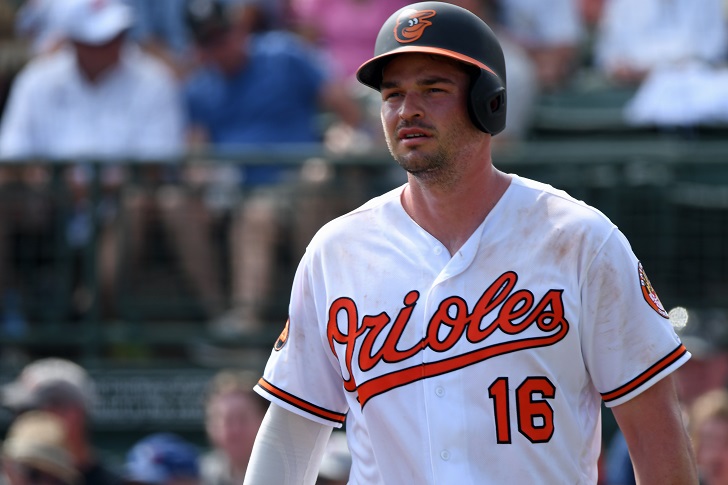
It’s even difficult to predict an annual salary on a contract. In 2019, Mancini batted .291/.364/.535 with 35 homers, 132 wRC+ and 3.5 fWAR. This season, he batted .255/.326/.432 with 21 homers, 105 wRC+ and 0.7 fWAR. While these numbers are very different, it’s worth noting this was Mancini’s first year back after beating cancer, which can make for an extremely long, tiring season. He batted .256/.331/.460 with 16 home runs and 114 wRC+ in 86 games in the first half of the season, while batting .254/.319/.392 with five home runs and 91 wRC+ in 61 games in the second half. The batting average stayed about the same and the walk rate took a slight dip, but the power production definitely tailed off in the second half.
Mancini told The Baltimore Sun’s Nathan Ruiz that while he was feeling good at the end of July, he felt the exhaustion in the final two months of the season.
“I was like, ‘Wow, I’m doing maybe even better than I thought I would.’ It kind of set in to me at that moment.
“And then I woke up the next day, and I’m like, ‘I have [freaking] two more months of this, and I’m tired.’”
So when it comes to contract negotiations, are you buying into Mancini’s 2019 or 2021 going forward? My bet is that it’s probably somewhere in the middle, sitting in the 115-to-125 wRC+, 25-to-30 home-run range. But it’s not up to me to throw darts or predict the future. The Orioles will have to do their own analysis of which Trey Mancini they’ll be getting for the next few years before deciding how much money to give him.
Another factor to take into consideration on whether or not to extend Mancini is simply the existence of Mountcastle, who started 82 games at first base this season, compared to 75 starts at first by Mancini. The Orioles showed this season that they’re not interested in experimenting with Mountcastle in left field any further, which leaves first base as the only option for him. Extending Mancini would be a commitment to filling both first base and designated hitter with full-time players, forgoing the opportunity to use the designated hitter spot as a flexible lineup spot. But if the Orioles’ front office is buying into 2019 Mancini, it could be worth it.
Are there any comps for a potential Mancini extension? Clearly, there aren’t any situations identical to his.
Earlier this week, the Colorado Rockies signed first baseman C.J. Cron to a two-year, $14.5 million extension. Cron posted better numbers than Mancini this season, batting .281/.375/.530 with 28 home runs, 127 wRC+ and 2.3 fWAR. It’s worth noting, however, that maybe Cron only got an annual salary of $7.25 million because this was the best season of his career. He had a very good 2.2-fWAR season with the Tampa Bay Rays in 2018, but wasn’t nearly as good in 2019 and 2020. Cron will be entering his age-32 season in 2022.
White Sox first baseman José Abreu posted a .284/.330/.503 slash line with 33 homers, 115 wRC+ and 1.7 fWAR in 2019, his final year of club control. Following the 2019 season, the White Sox gave Abreu the $17.8 million qualifying offer, which the first baseman accepted. Roughly a week later, Abreu and the White Sox reached an agreement on a three-year, $50 million contract extension. The annual average salary of $16.7 million may have seemed a little rich for a 33-year-old first baseman coming off a 1.7-fWAR season, but Abreu has been even better than his 2019 self since the extension.
Former major league first baseman/designated hitter Kendrys Morales had a solid two-year stint with the Kansas City Royals in 2015 and 2016. He batted .290/.362/.485 with 22 long balls, 131 wRC+ and 2.1 fWAR in 2015, and posted a .263/.327/.468 line with 30 home runs, 111 wRC+ and 0.9 fWAR in 2016. The then-34-year-old Morales was rewarded with a three-year, $33 million contract from the Toronto Blue Jays the following offseason, which didn’t exactly work out the best for Toronto. He wasn’t bad, but wasn’t exactly good, either. It could’ve gone worse, but I’m sure they wished they would’ve reallocated that $11 million average annual salary elsewhere.
I’d be insanely surprised if Mancini signs a deal for anything that looks similar to Cron’s extension in Colorado. But I also have a hard time imagining the Orioles giving Mancini as much as Chicago gave Abreu. I’d like to think Mancini could sign for more than what Morales got from the Blue Jays. The pre-contract batting lines of Cron, Abreu and Morales were similar to what Mancini’s doing in Baltimore. But like I said, the situations are definitely far from identical. It’s tough to pinpoint not only what Mancini could get from the Orioles, but what kind of contract he could receive on the open market if he reaches free agency following 2022.
Let’s say a contract extension isn’t, and won’t be, in the works. Would the Orioles consider trading Mancini away this offseason?
At the very least, this is a conversation that doesn’t need as much discussion and analysis as the idea of extending him.
I could very well see the Orioles listening to offers from other clubs for Mancini, but I’m not sure anything would change from how things went prior to the trade deadline this past July.
If the Orioles are listening to offers for Mancini, I assume they’re trying to find the right compensation to send away a player who is not only the clubhouse leader, fan favorite and inspirational figure, but also a player who they may believe can return to his 2019 self on the field. If another team is trying to trade for Mancini, they’re likely to base their offer on a first baseman who most recently batted .255/.326/.432 with 21 homers and 105 wRC+. I just don’t see how there could be a match for the Orioles to part ways with Mancini this offseason.
OK … So if the Orioles don’t extend nor trade Mancini this winter, then what happens?
Ride out 2022 and revisit these discussions at a later date.
When it comes to deciding whether or not to give Mancini a contract extension or trade him away, there’s no clear way to determine what his value is. Is his production at the plate going to be more like 2019, 2021 or somewhere in between?
My prediction is the Orioles will use 2022 to figure out what they’re getting out of Mancini on the field going forward. At that point, they can either decide to shop Mancini next summer, give him a contract extension or let him test the open market in the 2022-23 offseason.
I hope Mancini will remain an Oriole beyond the 2022 season. And hell, it would be pretty cool if he can stay in Baltimore for the rest of his career. He’s a competitor, a leader and the most accurate definition of inspirational. If the on-field performance is there, it’ll ultimately be up to the Orioles whether or not to show the money.

